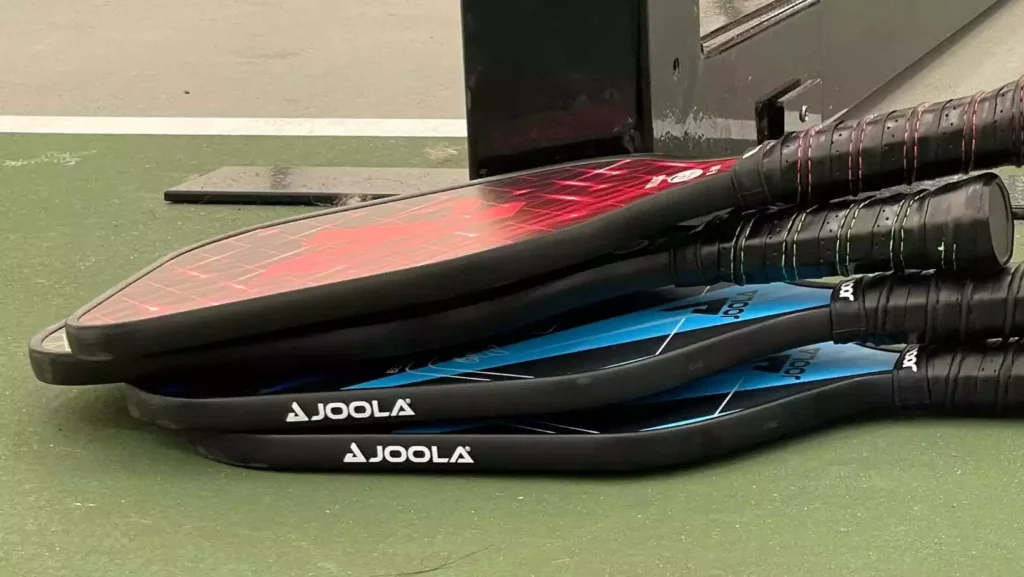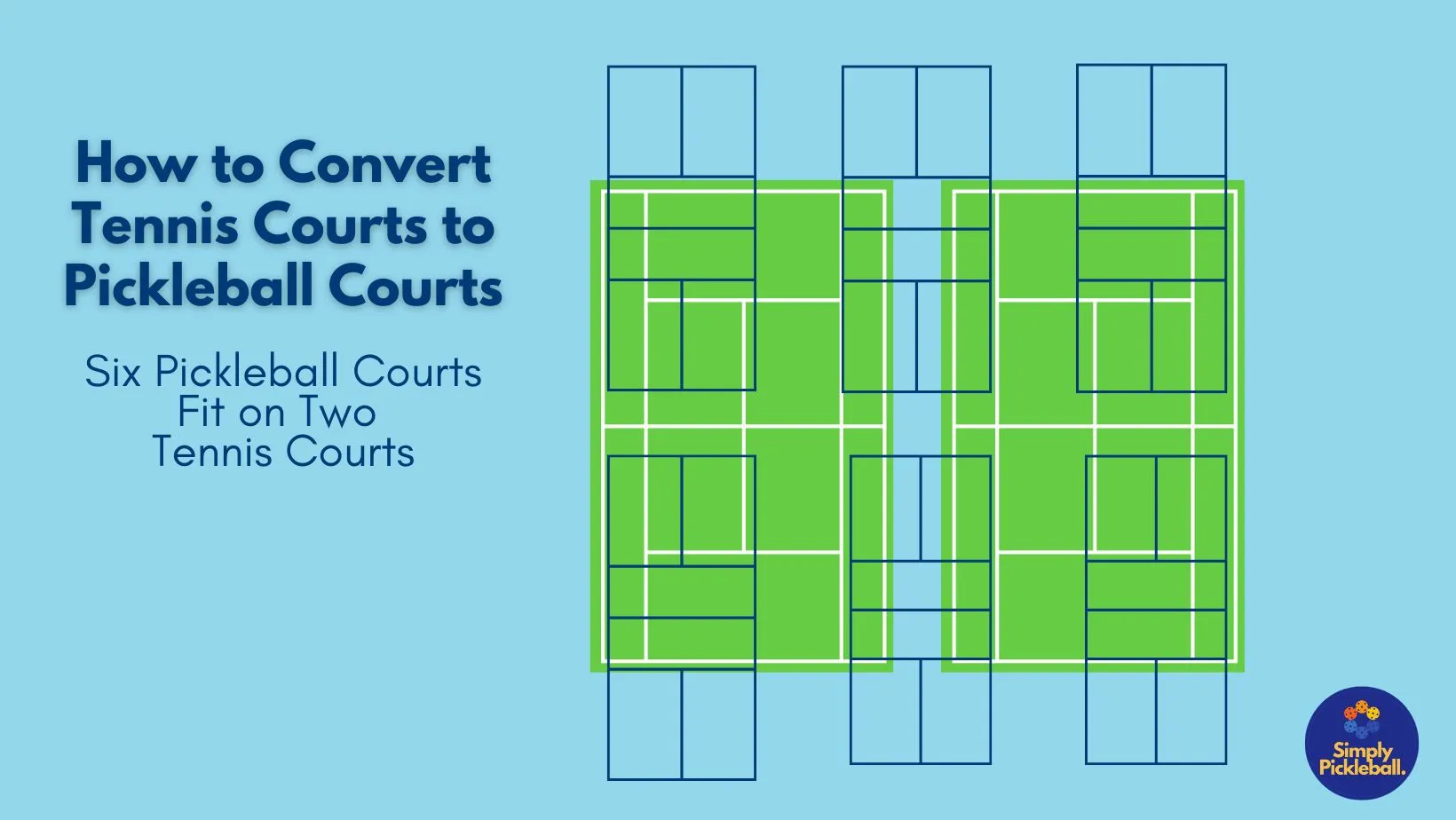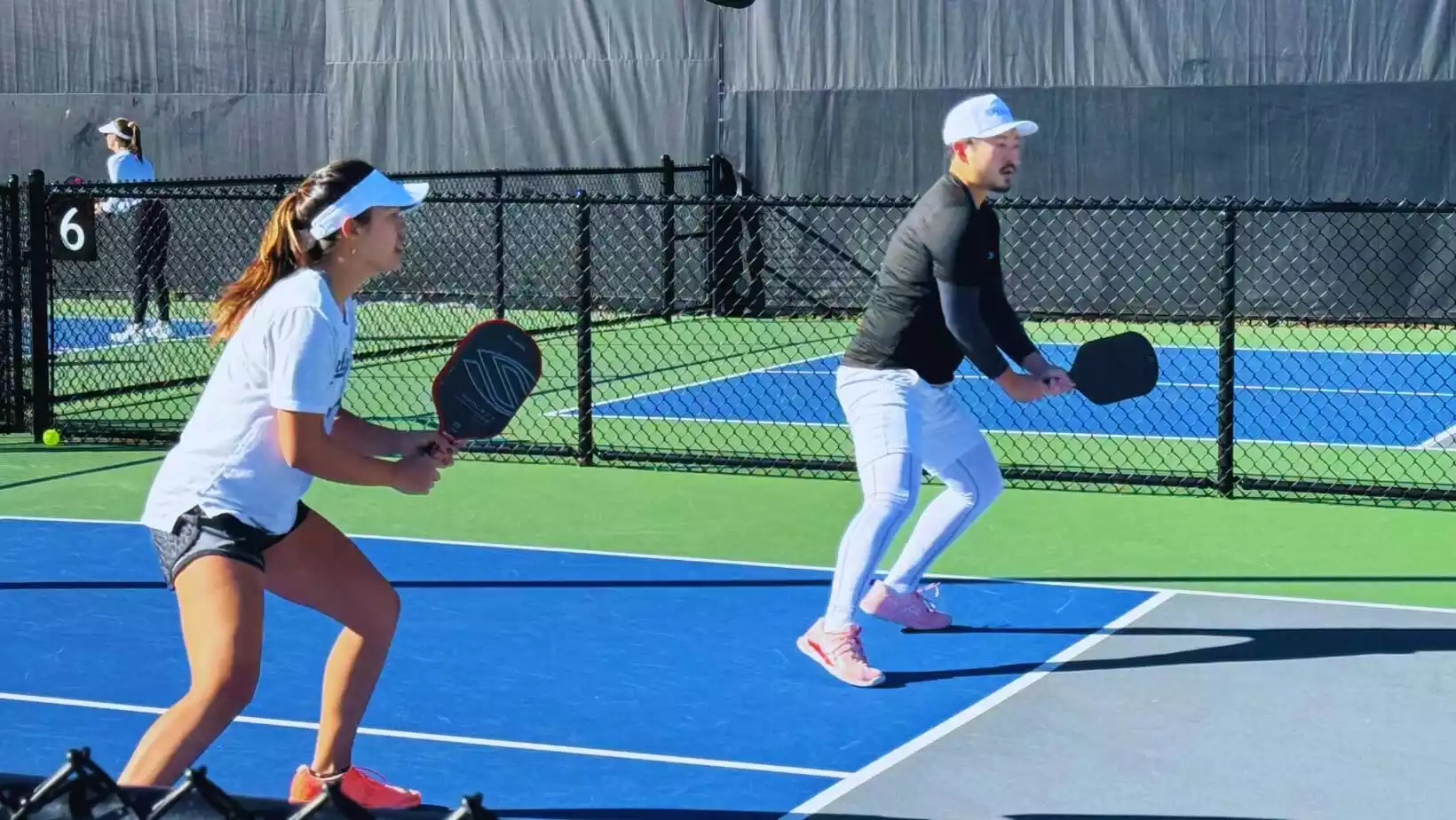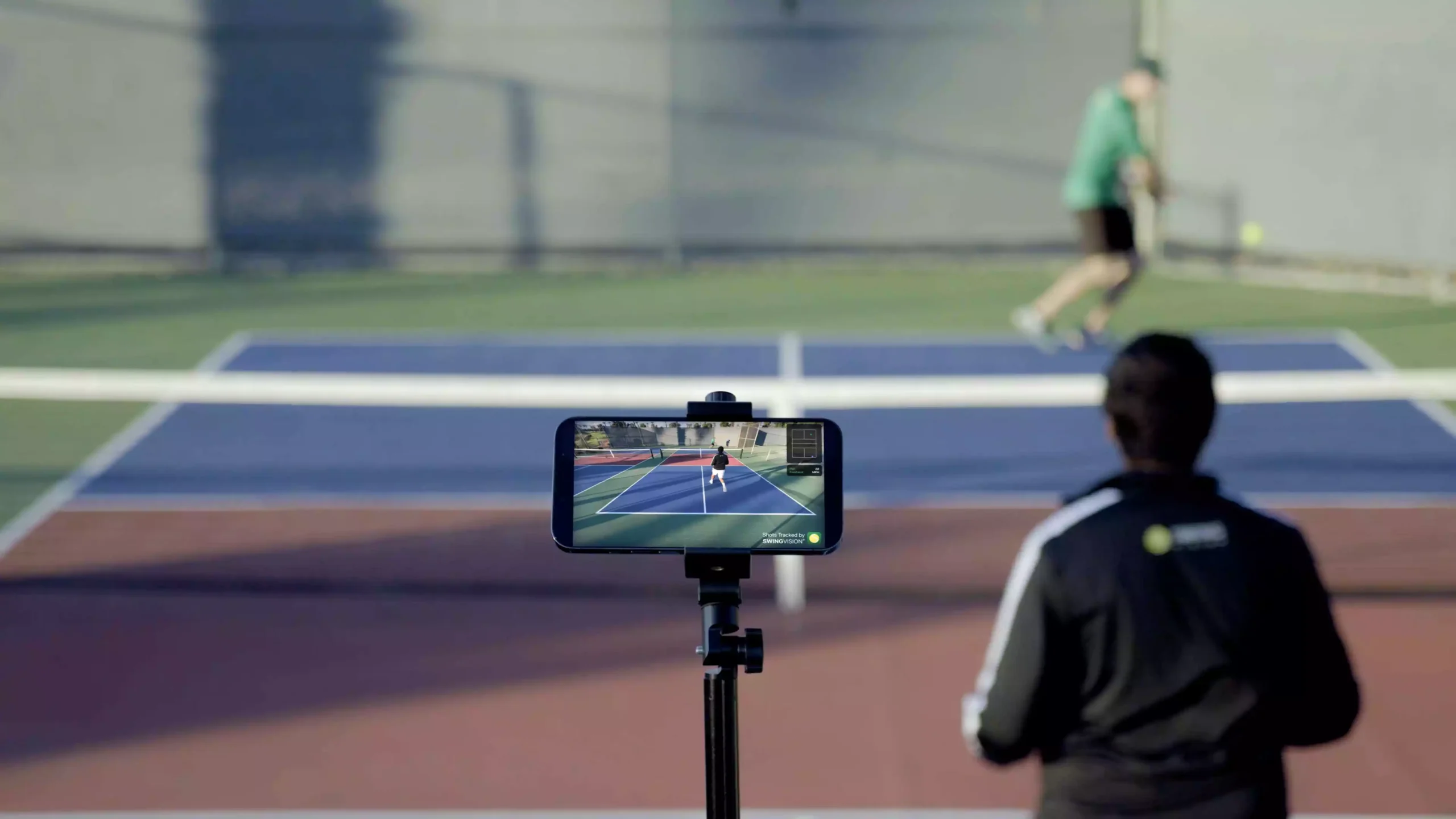When it comes to pickleball paddles, their longevity can be as variable as the game itself. Typically, paddles can last anywhere from 1 to 5 years with proper care and usage. However, if you play daily and hit the ball hard, your paddle may only last a few months. In this article, we’ll unravel the answer to “How long do pickleball paddles last,” highlight the factors contributing to your paddle’s life expectancy, and guide you through identifying the time for a replacement to ensure you remain at the top of your game.
Key Takeaways
Pickleball paddles have a variable lifespan of 1 to 5 years that can be extended through understanding material impact, adapting play frequency and intensity, and diligent care and maintenance.
Wear and tear on a pickleball paddle can present as physical changes such as a worn-down surface, changes in the sound or feel when hitting, or noticeable damage to the edge guard, all of which can affect paddle performance.
It’s important to recognize when to replace a paddle, which can be due to visible damage, performance issues, or to take advantage of technological upgrades. At the same time, proper storage and transport can help prolong paddle life.
Understanding Paddle Longevity

A pickleball paddle typically lasts from 1 to 5 years, with its lifespan being influenced by various factors. The pickleball paddle’s lifespan decreases when we start using it, with each serve, slice and shot marking its usage. Everything from the material the paddle is made from to how often we play and how well we care for our equipment affects how long pickleball paddles last.
However, a paddle’s longevity isn’t fixed. As players, we can prolong this timeline. By understanding the impact of materials, play frequency and intensity, and the importance of proper care and maintenance, we can prolong our paddle’s usability, optimizing our performance on the court.
Materials Matter
The durability and performance of a pickleball paddle depend significantly on the materials from which it is constructed. For example, wood paddles, while affordable, tend to have a shorter lifespan due to their more rapid deterioration. On the other hand, paddles with a polypropylene or polymer core, often featuring a honeycomb design, are favored for their optimal mechanical performance and longevity.
Contrastingly, graphite paddles provide more power but may wear quickly due to their lightweight nature. Composite paddles balance power and control but may also wear from frequent use. Therefore, understanding the pros and cons of different materials can help us choose a paddle that matches our playstyle and offers the most longevity.
Play Frequency and Intensity
The frequency and intensity of our play directly affects the durability of our pickleball paddles. For example, frequent play can hasten the wear of graphite or composite paddles. Moreover, intense play, characterized by aggressive strokes, exerts more significant stress on paddles, leading to quicker degradation.
However, paddle longevity isn’t equally impacted by all playstyles. Players who employ a style centered on finesse and touch exert less stress on their paddles, potentially extending their usability. Thus, understanding our playstyle and adjusting our gameplay can be a strategic move toward prolonging our paddle’s lifespan.
Care and Maintenance
Taking proper care of your paddle can prolong its lifespan significantly. Simple practices like cleaning the paddle after each game with a damp cloth can maintain surface performance and preserve its grit for ball control. Using a carbon fiber cleaning block can effectively remove debris for paddles with raw carbon fiber faces. Read our blog on How to Clean a Carbon Fiber Pickleball Paddle.
Regularly inspecting the edge guard and reinforcing it with tape protects it from wear and tear. Frequent replacement of worn-out edge guard tape, and temporary fixes with strong glue can be short-term solutions. Maintaining the paddle’s grip by wiping it after cleaning and replacing it when it shows wear can also extend the paddle’s lifespan.
Additionally, here are some tips to prolong the life of your paddle:
Rotate the paddle during gameplay to evenly distribute wear and prevent leaning or tapping that could damage the paddle.
Avoid submerging the paddle in water to prevent moisture damage.
Repair any minor damages immediately while on the go to prevent further damage and prolong the paddle’s life.
Identifying Wear and Tear on Your Paddle

For a pickleball enthusiast, knowing how to identify wear and tear on your paddle to maintain peak performance is vital. Visible wear, such as a worn-down textured surface meant for spin, indicates that the paddle might end its useful life and be due for replacement. Changes in how a paddle feels, including weight distribution, grip wear, and different responses when hitting the ball, are tell-tale signs that the paddle may need to be replaced.
Dead spots in the paddle’s sweet spot can be identified by a change in feel and sound during play. These negatively impact the paddle’s performance and could signify a need for a new paddle. Identifying these signs will help you stay ahead of the game and ensure your gear is always in top shape.
Surface Scrutiny
The surface of your pickleball paddle may exhibit signs of deterioration over time. Spin-heavy playing techniques can lead to quicker wear of the paddle surface due to increased friction and torque. Scratches, scrapes, and dead spots on the paddle surface may not immediately affect playability unless located in the sweet spot, which is crucial for optimal performance.
By regularly scrutinizing your paddle’s surface, you can stay aware of any developing wear and tear. This practice lets you decide when to replace your paddle, ensuring you’re always playing at your best.
Core Concerns
The core of a paddle is crucial, and damage to it can significantly impair its performance. Delamination, when the outer surface separates from the paddle’s core, negatively impacts the sweet spot and overall performance. Hard-hitting and aggressive play styles place additional stress on the paddle’s core and surface, which can accelerate degradation and contribute to delamination.
However, not all core concerns are visible. Inconsistencies in sound when tapping different areas of the paddle and a change in sound when the ball contacts the sweet spot are auditory indicators of potential core damage. The thumb test, which involves pressing the center of the paddle with thumbs and listening for a crackling noise, can be used to check for delamination.
Awareness of these subtle issues can help you address them early, ensuring your paddle stays in game shape.
Edge Guard Examination
The edge guard of a pickleball paddle serves a crucial role in protecting the side of the paddle from damage, thus holding the core materials in place and providing extra durability to the paddle. Damage or breaks around the edges of the paddle can be identified by visual inspection and by feeling for irregularities in the edge guard’s surface.
A compromised edge guard can lead to the paddle gradually falling apart, emphasizing the critical role the edge guard plays in keeping the core intact. A broken or cracked edge guard is often not easily replaceable, making the prevention and protection of the edge guard essential for maintaining optimum paddle performance. Regular inspection and maintenance of the edge guard can help extend the life of your paddle, ensuring you get the most out of your equipment.
When to Consider a New Paddle

Recognizing when to contemplate a new paddle is as crucial as knowing how to take care of and sustain your existing one. Signs of degradation such as:
cracks
warping
dents
a worn-down texture
lack of power
decreased control
inconsistent results
changes in sound
It may signal that it’s time for a replacement. Deciding between repairing or replacing a pickleball paddle involves considering the costs, with repairs costing $20 to $50+ and new paddles costing $50 to $200+.
While recreational players typically replace their paddles every 1 to 3 years, professionals may need new paddles every few months or weeks due to their intense play frequency. Furthermore, advancement in paddle technology can be a compelling reason to consider new paddles, offering improved performance through new materials and designs.
Performance Drop-offs
Noticing performance drop-offs can be a sign that it may be time to think about a new paddle. A pickleball paddle reaching the end of its useful life may exhibit:
Less power
Less control
Inconsistent results, even when hitting the ball in the same spot
A change in feel from shots in the sweet spot, signaling damaged equipment and suboptimal performance
These could all be signs that your compromised paddle, with its worn-out paddle face, needs to be replaced.
Inconsistent sounds when tapping different paddle parts can suggest it’s worn out and may negatively affect gameplay performance. Being aware of these performance drop-offs can help you stay ahead of the curve and ensure you’re always using equipment that’s in top shape.
Technological Upgrades
The swift progress in pickleball technology can provide persuasive reasons to upgrade your paddle. Major paddle brands continually develop new technologies, shapes, and materials to enhance players’ games beyond what older models offer. When a paddle is considered ‘dead,’ players might look for a replacement that includes the latest technology to maximize the quality of their shots and improve their game.
Upgrading to a new paddle with advanced technology can help players who need to replace a paddle due to wear and tear, as it could optimize performance beyond what their old paddle could offer. Staying updated with the latest advancements in paddle technology can help you decide when to consider a new paddle.
Check out our recommendations for Intermediate Pickleball Paddles.
The Right Storage and Transportation for Your Paddle

Appropriate storage and transportation are vital for shielding your paddles from harm and prolonging their lifespan. Avoiding extreme temperatures is critical for pickleball paddle longevity; for instance, don’t store paddles in the car trunk or an uninsulated garage.
A dedicated pickleball bag with separate compartments can prevent scratches and other damage to paddles. A paddle cover provides additional protection against scratches and is useful for storing and transporting your paddle. A hard case is recommended for your pickleball paddle for superior protection against impacts and pressure, especially when traveling. Check out our Best Pickleball Bags for 2024.
At Home
The way you store your paddle at home can have a substantial impact on its longevity. Pickleball paddles should be stored in a temperature-controlled environment to prevent damage caused by heat or cold. A dry, room-temperature closet is ideal for paddle storage to mitigate the risk of temperature extremes.
Additionally, a paddle with an edge guard can provide extra security against chips and damage to the paddle edges while stored. By storing your paddle correctly at home, you can help ensure it remains in optimal condition for the next pickleball game.
On the Go
When traveling, it’s vital to safeguard your paddle. Make sure to use a bag designed explicitly for pickleball equipment to protect the paddle from accidental damage. Specialized pickleball bags with padding and compartments designed to protect paddles from impacts and scratches while traveling are a significant investment.
Applying edge guard tape to your paddle can protect it from damage during travel and prevent the paddle’s edge from chipping or peeling. With the proper protective measures, you can ensure your pickleball paddle stays in top shape, no matter where your pickleball adventures take you.
Demo Before You Buy: Trying Out New Paddles

Consider using demo programs to test out a new paddle before committing. These programs allow players to borrow different paddles to test on the court before purchasing. This way, you can ensure the paddle you choose offers optimized performance features that enhance your style of play.
Demo programs typically allow players to test multiple paddles over up to one week for a small fee or deposit. This resource can be valuable, primarily when investing in a high-quality paddle.
Why Demos Work
Demo programs are advantageous as they:
Prevent unnecessary spending on equipment that may not meet your needs
Allow you to try out different paddles
Before committing, help you discover which paddle best suits your playing style and preference.
This way, you can ensure that your investment is well-spent on a paddle that will last and enhance your gameplay. So, why not use these programs to find your perfect fit?
Accessing Demo Programs
Demo programs are easily accessible and convenient to use. Customers select the paddles they want to try, and the program ships them for a trial period. Various providers, such as PickleballGalaxy, Total Pickleball, and Tennis-Point, offer demo programs where players can choose multiple paddles for a week-long trial.
Local sporting goods stores and pickleball clubs may also conduct paddle demo programs that vary in policies and available paddle selection. Demo programs typically include a prepaid return shipping label, making sending the paddles back after the trial convenient. Customer service also plays a crucial role in the demo experience, with staff available to assist with paddle selection and resolve issues.
By trying a demo paddle, you can make an informed decision and choose the perfect paddle to dominate the pickleball court. Don’t miss our pickleball paddle demos to find the right fit for you.
Summary
In conclusion, understanding pickleball paddle longevity and identifying wear and tear can help maximize your play and ensure the best performance. From selecting suitable materials to understanding the impact of play frequency and intensity, proper care, and maintenance, you can extend the lifespan of your paddle.
Recognizing when it’s time to consider a new paddle, whether due to performance drop-offs or technological upgrades, and knowing the right way to store and transport your paddle can significantly impact its longevity. Lastly, taking advantage of demo programs before purchasing can ensure you choose the best paddle.
Remember, every serve, slice, or shot is an opportunity to play at your best, and having the right equipment can make all the difference!
Frequently Asked Questions
How do you know if your pickleball paddle is worn out?
If your pickleball paddle sounds different in different parts, especially the edge guard and sweet spot, it may have a dead spot and be worn out. Consider replacing it if you notice this.
How many games does a pickleball paddle last?
A pickleball paddle should last between 1 and 3 years, depending on factors such as game style, frequency of play, and maintenance.
How do you know if your pickleball paddle is cracked?
You can know if your pickleball paddle is cracked by visually inspecting it for chips, wear, or visible dents on the face. If you see any of these signs, it’s likely that the paddle has lost its optimal performance.
How can I extend the lifespan of my pickleball paddle?
To extend the lifespan of your pickleball paddle, make sure to clean it after each game, inspect the edge guard regularly, and maintain the grip. Regular care and maintenance is key to prolonging its life.
What are some signs that my paddle may need to be replaced?
If you notice visible wear on the paddle, such as changes in weight distribution and grip wear, along with a different response when hitting the ball, it may be time to replace it.
Join thousands of fellow pickleball players from around the world. Subscribe today!








